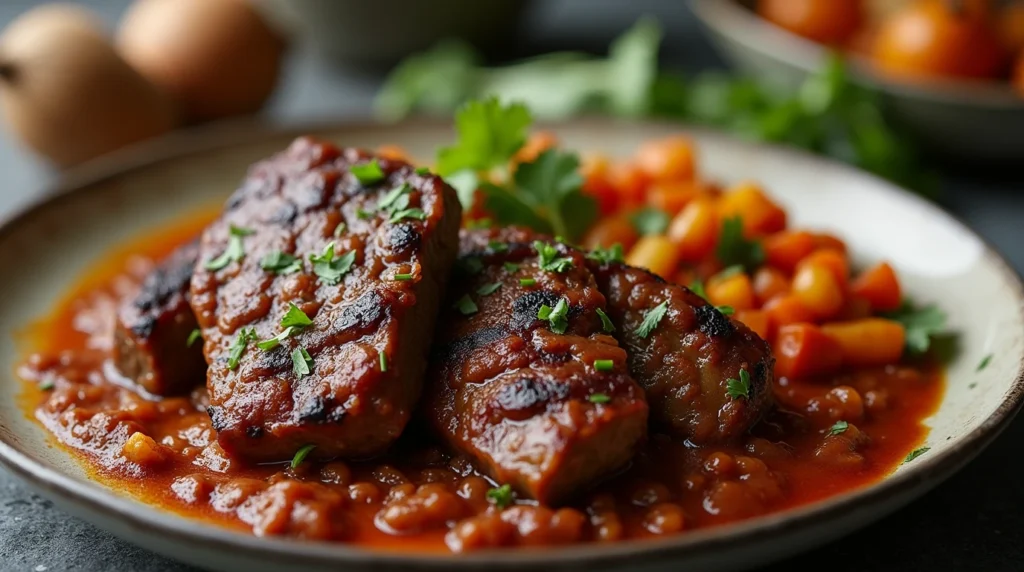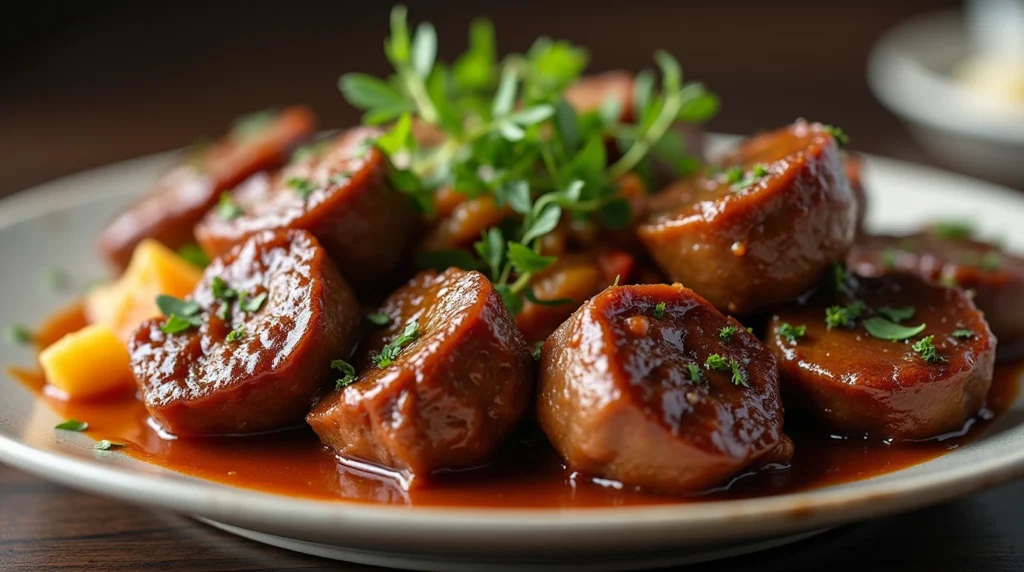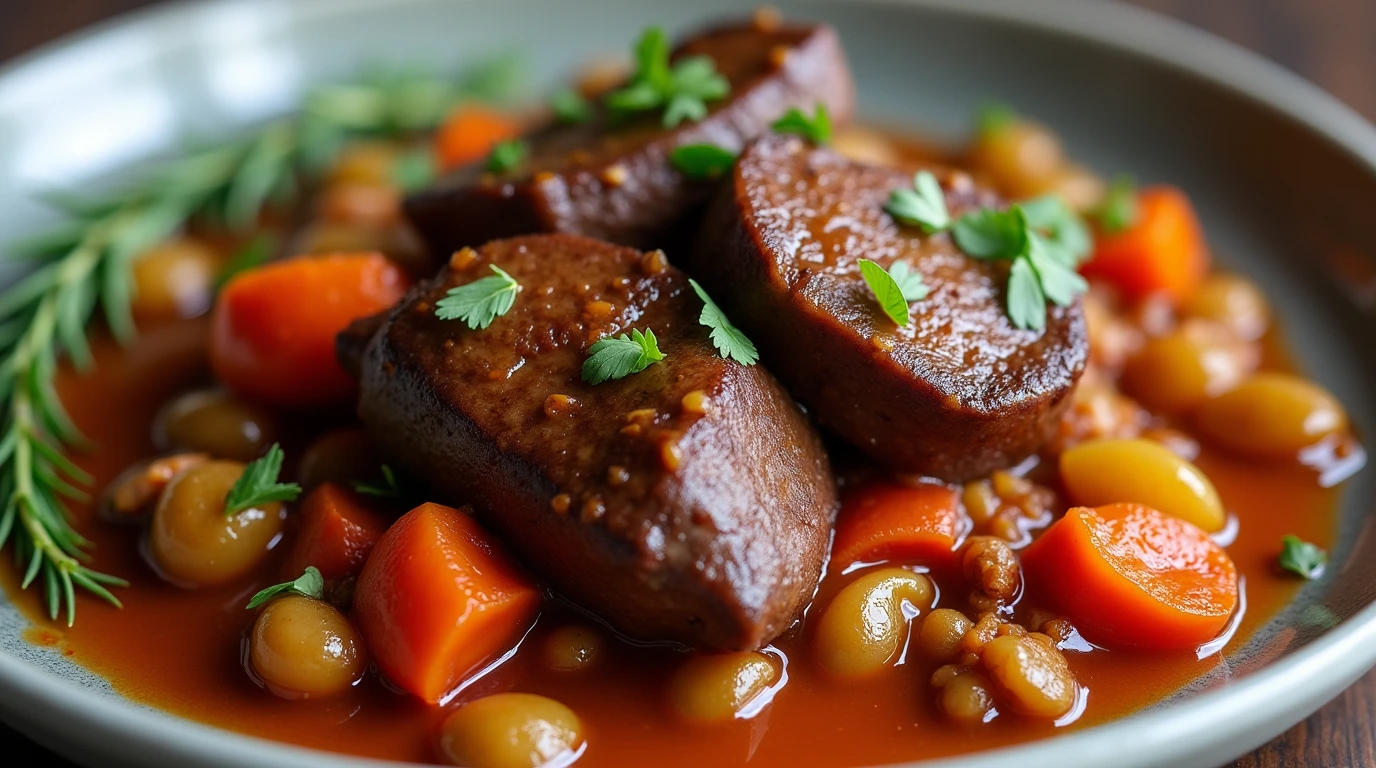Introduction
Beef cheek meat is often overlooked but is one of the most flavorful and tender cuts of beef when prepared correctly. Whether you’re a seasoned cook or a beginner looking to try something new, this beef cheek meat recipe will have you creating mouthwatering dishes in no time. In this article, we’ll explore various simple yet savory recipes that will make beef cheeks the star of your meals. From slow-cooked stews to braised dishes, beef cheeks offer rich flavor and melt-in-your-mouth texture, perfect for any home chef.
What is Beef Cheek Meat?
Beef cheek meat comes from the facial muscles of a cow, and it’s often considered a lesser-known cut. However, when cooked low and slow, it becomes incredibly tender and flavorful. The muscle fibers in the cheek are packed with collagen, which breaks down during cooking, resulting in a rich, savory dish. Due to its richness and depth of flavor, beef cheek is a favorite in many cuisines around the world, including Mexican, French, and Italian.
Nutritional Benefits of Beef Cheek Meat
Beef cheek is not only delicious, but it also offers several health benefits. Rich in protein and packed with essential minerals like zinc and iron, this cut provides a nutritional punch that supports muscle growth and immune function. Additionally, it contains collagen, which can benefit skin health and joint function. If you’re looking to add variety to your diet while still maintaining nutritional balance, beef cheek meat is an excellent choice.
How to Prepare Beef Cheek Meat
Beef cheek meat, though often considered an unconventional cut, can yield some of the most delicious and tender dishes when cooked properly. The preparation of beef cheeks is crucial to unlocking their full flavor and texture. Here’s an in-depth look at the various methods of preparing beef cheek meat, from braising to slow cooking, so you can achieve a melt-in-your-mouth result every time.

1. Braising Beef Cheeks
Braising is one of the most effective ways to prepare beef cheek meat. This technique involves cooking the meat slowly in liquid, which helps break down the tough muscle fibers, transforming the cut into a tender and flavorful dish. The beauty of braising lies in its ability to infuse the beef cheeks with rich, savory flavors while maintaining their juicy texture.
When braising, it’s essential to use a heavy, lidded pot like a Dutch oven or a slow-cooker that retains moisture during the cooking process.
Step-by-Step Braising Method:
- Searing the Beef Cheeks: Begin by seasoning the beef cheeks generously with salt and pepper. Heat a bit of olive oil in a large Dutch oven over medium-high heat. Once the oil is hot, add the beef cheeks and sear them on all sides until they develop a deep brown crust. This step helps to lock in flavor and provides a foundation for the dish.
- Cooking the Aromatics: After searing the beef cheeks, remove them from the pot and set them aside. In the same pot, add chopped onions, garlic, carrots, and celery (also known as the “holy trinity” in French cuisine). Sauté the vegetables until they soften, about 5 minutes, releasing their natural sweetness and deepening the dish’s flavor profile.
- Deglazing the Pot: Once the vegetables are tender, pour in a liquid such as red wine, beef broth, or a combination of both. The wine adds acidity, which balances the richness of the beef, while the broth infuses the dish with additional flavor. Use a wooden spoon to scrape up any browned bits stuck to the bottom of the pot — these are packed with flavor.
- Simmering with Herbs: Return the seared beef cheeks to the pot. Add fresh herbs like thyme, rosemary, or bay leaves for extra flavor. Make sure the beef cheeks are mostly submerged in the liquid. Cover the pot with a lid and transfer it to a preheated oven set at 325°F (163°C). Braise the meat for 2-3 hours, or until it’s fork-tender. During this time, the collagen in the meat breaks down, resulting in a rich, melt-in-your-mouth texture.
- Finishing the Dish: Once the beef cheeks are cooked, remove them from the liquid. You can serve them as-is or shred them for tacos, sandwiches, or stews. For the sauce, simmer the braising liquid on the stovetop until it thickens into a rich gravy.
2. Slow Cooker Beef Cheeks
For those looking for a hands-off approach, the slow cooker is an ideal method to prepare beef cheek meat. Slow cooking allows the beef to become extremely tender while absorbing the flavors of the ingredients. The beauty of using a slow cooker is that you can set it and forget it, allowing the beef to cook for several hours without having to monitor it constantly.
Step-by-Step Slow Cooker Method:
- Preparing the Beef Cheeks: Season the beef cheeks liberally with salt, pepper, and any spices of your choice. Common additions include paprika, cumin, chili powder, or smoked paprika. These spices complement the natural beef flavor and add depth to the dish.
- Searing (Optional): Although it’s not strictly necessary, searing the beef cheeks in a hot pan with a little oil before transferring them to the slow cooker can add extra flavor. Searing creates a brown crust on the meat that enhances the overall taste.
- Layering the Ingredients: Place the seared beef cheeks at the bottom of the slow cooker. Add aromatic vegetables like onions, garlic, and bell peppers, along with any herbs or spices. Pour in your choice of liquid, such as beef broth, wine, or even a combination of tomato paste and broth for a richer flavor profile. The liquid helps tenderize the beef as it cooks.
- Slow Cooking: Cover the slow cooker and set it to cook on low for 7-8 hours, or until the beef cheeks are fork-tender and can be easily shredded. The slow cooker’s low, even heat breaks down the collagen in the beef, transforming it into a melt-in-your-mouth texture.
- Shredding and Serving: Once the beef is fully cooked, remove it from the slow cooker and shred it with two forks. The shredded beef can be served in tacos, sandwiches, or over mashed potatoes. Don’t forget to spoon some of the delicious cooking liquid over the top for added richness.

3. Grilling or Roasting Beef Cheeks
Although less common than braising or slow cooking, grilling or roasting beef cheeks can produce a flavorful, charred exterior. However, this method requires a bit more attention to ensure that the beef doesn’t dry out. If you prefer a slightly smoky flavor and a crispy exterior, grilling is an option to consider.
Step-by-Step Grilling or Roasting Method:
- Marinating the Beef Cheeks: Before grilling, marinate the beef cheeks in a mixture of oil, vinegar, garlic, and spices for at least 2 hours. This helps tenderize the meat and infuse it with flavor. Popular marinade ingredients include balsamic vinegar, soy sauce, and various herbs like thyme or rosemary.
- Grilling: Preheat the grill to medium-high heat. Place the beef cheeks directly on the grill and cook for about 4-5 minutes on each side, depending on the size of the cheeks. The goal is to develop a crispy, caramelized crust on the outside while keeping the inside moist and tender.
- Roasting (Alternative): If you prefer to roast beef cheeks in the oven, you can roast them at a high temperature (around 400°F or 200°C) for 30-40 minutes. Baste the cheeks with their own juices or additional marinade halfway through cooking to keep them moist.
- Finishing Touches: Once grilled or roasted, allow the beef cheeks to rest for a few minutes before slicing. The result will be a tender interior with a slightly crisp exterior, which adds a delightful contrast in textures.
4. Beef Cheek Stew or Ragu
A beef cheek stew or ragu can be a perfect solution for incorporating this cut into a comforting, hearty meal. In these dishes, beef cheeks are cooked in a flavorful sauce with vegetables and herbs, creating a rich and savory meal.
Step-by-Step Stew/Ragu Method:
- Browning the Beef Cheeks: First, season and brown the beef cheeks as described in the braising method. This step helps develop the deep, savory flavors that will infuse the entire stew or ragu.
- Building the Stew Base: Add chopped onions, garlic, and carrots to the pan, cooking until softened. Then, pour in a rich liquid (beef broth, red wine, or tomato sauce) and bring the mixture to a simmer.
- Simmering the Beef: Add the beef cheeks back into the pot along with any herbs, such as thyme, bay leaves, or rosemary. Cover and simmer gently for 2-3 hours, or until the beef cheeks become tender and the flavors meld together.
- Serving: Once the beef cheeks are tender, shred the meat and mix it back into the sauce for a ragu, or serve the entire beef cheeks whole in a rich stew. This is perfect served over pasta, rice, or mashed potatoes.
By following these detailed preparation methods, you’ll be able to unlock the full potential of beef cheek meat. Whether you prefer slow-cooked tenderness, a rich stew, or a smoky grilled option, beef cheeks can be transformed into a variety of mouthwatering dishes. The key is patience, proper seasoning, and low-and-slow cooking techniques that make this cut of meat truly shine.
Frequently Asked Questions (FAQs)
What is beef cheek meat?
Beef cheek meat is a cut from the cow’s facial muscles. It’s known for its rich flavor and tender texture when slow-cooked.
Is beef cheek meat tough?
Although beef cheek meat is initially tough, it becomes very tender when cooked slowly, especially through methods like braising or slow cooking.
Does beef cheek taste like steak?
Beef cheek has a different texture than steak. While steak is tender and juicy, beef cheek is rich, with a deep, savory flavor that comes from the collagen and fat content.
Is beef cheek good to eat?
Yes, beef cheek is not only flavorful but also a nutritious cut of meat, rich in protein and collagen. It’s a great addition to your meals if you enjoy tender, savory dishes.

Conclusion
Beef cheek meat is a hidden gem in the world of beef cuts, offering an incredibly tender, flavorful, and versatile option for a variety of dishes. Despite its reputation as a lesser-known cut, beef cheeks can transform into mouthwatering meals when prepared using the right methods. Whether you’re braising, slow cooking, grilling, or making a stew, the rich flavor and melt-in-your-mouth texture of beef cheek meat make it a favorite for chefs and home cooks alike.
Cooking beef cheeks allows you to experiment with different flavors and techniques, from the savory depth of a slow-cooked stew to the smoky crispiness of grilled beef cheeks. This cut is perfect for those who appreciate a more rustic, flavorful dining experience and want to try something beyond the usual steaks or roasts. Plus, with its rich nutritional profile, including high levels of collagen, protein, and iron, beef cheeks provide not just an amazing culinary experience but also several health benefits.
The beauty of this cut lies in its flexibility. You can easily adapt your beef cheek meat recipe to suit different cuisines and occasions. Want something hearty for a cold evening? Go for a braised beef cheek stew. Craving something lighter and fresher for summer? Try shredded beef cheeks in tacos with a squeeze of lime and a sprinkle of cilantro. The possibilities are endless, and each dish offers a unique way to enjoy this incredibly tender and flavorful meat.
The best part? Beef cheek meat is often more affordable than premium cuts like rib-eye or filet mignon, making it an excellent option for budget-conscious cooks who don’t want to compromise on taste. It’s an affordable luxury that, once you’ve mastered the cooking techniques, can elevate any meal.
Incorporating beef cheek meat into your culinary repertoire not only provides variety to your meals but also offers the satisfaction of cooking with a cut that’s rich in history and flavor. So, next time you’re at the butcher or grocery store, consider giving beef cheeks a try. With a little patience and the right techniques, you’ll be rewarded with a delicious, tender meal that your family and friends will love.
So, go ahead and experiment with these beef cheek meat recipes—simple, savory, and incredibly satisfying dishes await you. After all, food is about more than just eating; it’s about experiencing new flavors, sharing meals with loved ones, and creating lasting memories. Let beef cheeks become your new favorite dish to make those moments even more special.
For more recipes please click on below links:
Easy Sub in a Tub Recipe: A Perfect Sandwich-Inspired Bowl
Best Flank Steak Alternatives for Juicy and Tender Results
Easy Sloppy Joe Recipe with 3 Ingredients: Quick and Delicious

